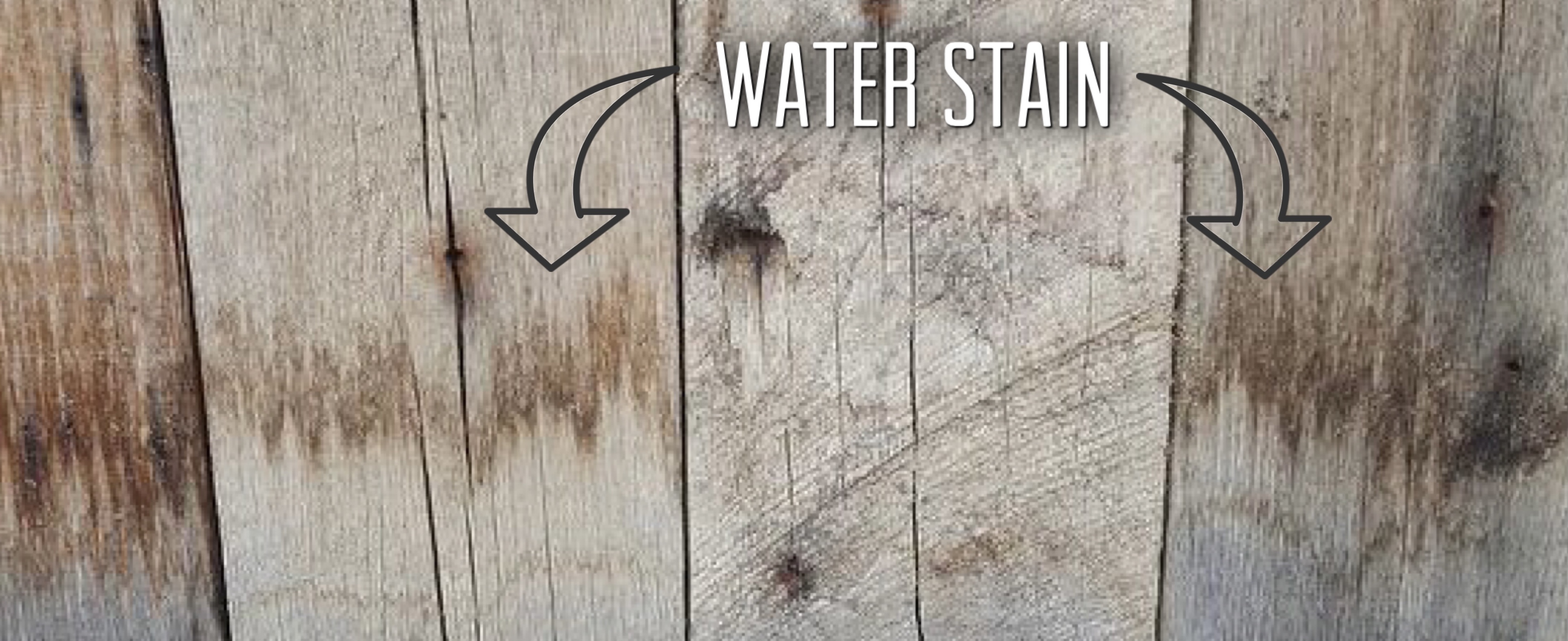- Recent Posts
- Archives
- Subscribe
Sep 17, 2021

Introduction
We are occasionally asked for ideas about how to prevent or eliminate water staining on wood siding and other wood products used in exterior applications.
We believe that one of the most important things we can do in responding to such inquiries is to help establish realistic expectations. Wood used in exterior applications is going to be exposed to weather elements (which elements often involve moisture.) These elements can be expected to change the appearance of the wood in various ways.
We think that one of the best ways to look at water staining is as just one way in which nature interacts with your wood and creates a unique, one-of-a-kind look for your project. In other words, water staining adds to the rustic character of your wood.
What if you like rustic character in general but are not fond of water staining in particular? Are there steps you can take to minimize or reduce water staining? We are not experts on this, but would put forward the following possibilities based on things we have seen and/or read:
What is Water Staining?

Water staining can be defined as a "wood stain in which water is the dispersion medium" (1). This means that the water in or on the wood does not form a “distributed medium” or in other words does not mix with the wood. When the water does not mix with the wood, it forms a water stain which is often found as a streak or discoloration boundary which may appear as a brown wandering line on the wood. Wood siding is more likely to have water stains after big winter and spring seasons because of snow deposits and water pooling that "rest" on or under the wood.
Some Possible Approaches
Approach #1: Sealing the End Grain of the Wood
One possible approach is to seal the end grain of the wood siding. In the article titled “How to Remove Water Stains From Wood”, Lee Wallender states that, “Applying oil- and water-based wood sealers in advance and regularly sealing the wood is the best way to avoid water staining” (2).
The end grain of the wood siding is often exposed at the soil and roof line. Both the soil and roof line can have major water pooling or runoff from the tremendous amounts of snow and water that the winter and spring seasons can bring. All this moisture from these two “wet” seasons lead to the end grain of the wood siding absorbing the water and eventually appearing as a water stain.
Two products that could be considered for end grain sealing are the Anchorseal 2 End Sealer and Seal Once End Sealer. The manufacturers of both products say they provide protection against water, mold, and decay.
Approach #2: Apply a 50% Bleach/50% Water Solution
A second potential approach that can be taken is to scrub the water stain with a 50% Bleach and 50% Water Solution. Bleach is a common chemical solution that is used in removing stains on clothes, disinfecting surfaces like kitchen counters, and helping keep swimming pools clean.
Note that bleaches are oxidative agents (3). Under certain conditions, oxidative agents can gain electrons from another reactant which can result in (a) the formation of a dangerous byproduct or, when applied to wood, (b) the creation of significantly lighter areas on the wood (4). This is the reason that bleach should be diluted before being applied to wood.
To create and apply the solution
1) Get necessary supplies: bleach, water, dense sponge, spray bottle, and waterproof gloves.
2) Mix equal amounts of the bleach and water and pour into a spray bottle or bucket.
3) Lightly apply or spray the 50% Bleach/50% Water solution onto the water-stained area (be careful to not let the solution
drip on unaffected areas).
4) Allow the wood to dry completely for a couple hours to a day.
5) If the stain has not disappeared, then repeat the steps above until the color of the water-stained area is to your liking (see more photos here).
6) Other methods we have seen work include (a) applying the bleach to the water-stained area and immediately scrubbing with a bristled brush and (b) making a stronger solution of 75% Bleach/25% Water and repeating the steps listed above (both methods may take off more of the patina).
Approach #s 3 and 4: Sand or Pressure Wash
A third and fourth potential approach that can be taken is to lightly sand or pressure wash the patina of the wood to remove the water stain. The sanding and pressure washing processes can be referred to as a “process of abrading wood fibers so that they are rendered uniformly rough” (5).
Both sanding and pressure washing will likely eliminate much of the water stain on the wood siding along with the majority of the patina underneath. Keep in mind that removing water stains from wood does not protect the wood from future water staining.

References
1. Merriam-Webster. (n.d.). Water stain. In Merriam-Webster.com dictionary. Retrieved July 8, 2021, from https://www.merriam-webster.com/dictionary/water%20stain
2. Wallender, L. (2020, September 30). How to Remove Water Stains From Wood. The Spruce. https://www.thespruce.com/how-to-remove-water-stains-from-wood-4690767.
3. Sandoval, M. (2009, November 24). How Bleach Works. HowStuffWorks. https://home.howstuffworks.com/bleach.htm.
4. Helmenstine, A. M. (2020, April 5). What Is an Oxidizing Agent? ThoughtCo. https://www.thoughtco.com/definition-of-oxidizing-agent-605459.
5. Gardner, C. (2020, October 21). How To: Sand Wood. Bob Vila. https://www.bobvila.com/articles/sanding-wood/.
Make sure to leave a comment if you enjoyed this blog post and stay tuned for more blog posts in the future!
Comments: